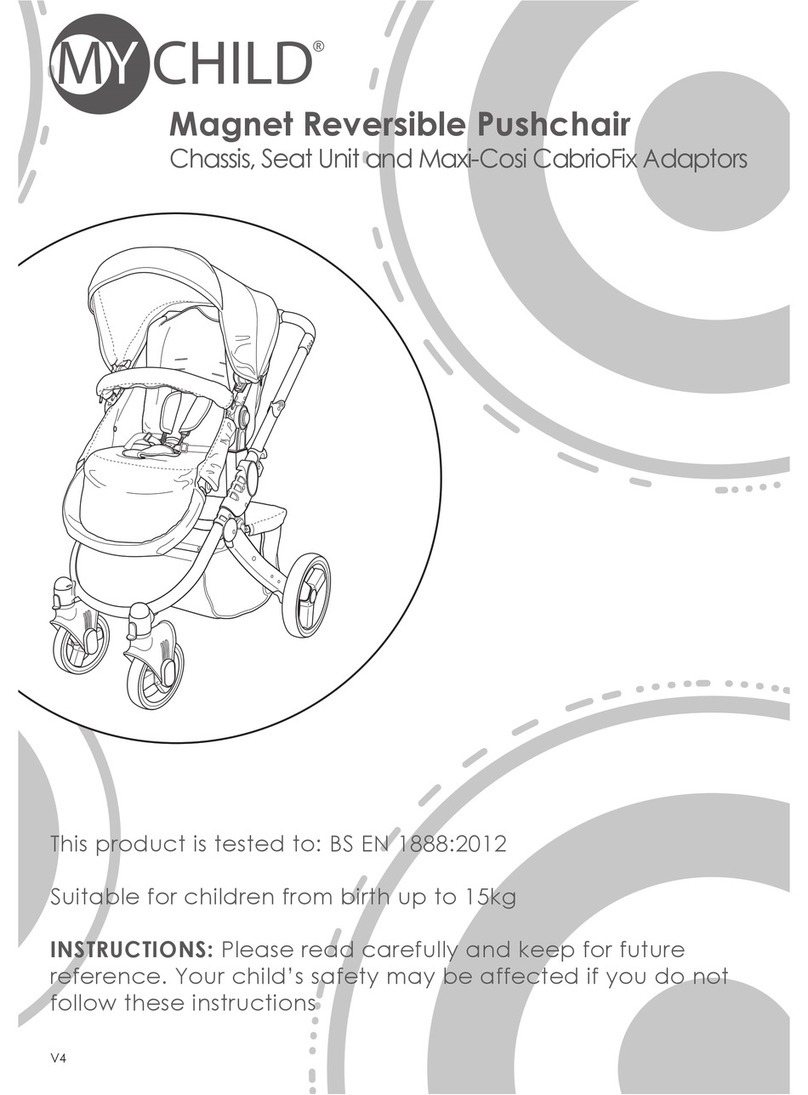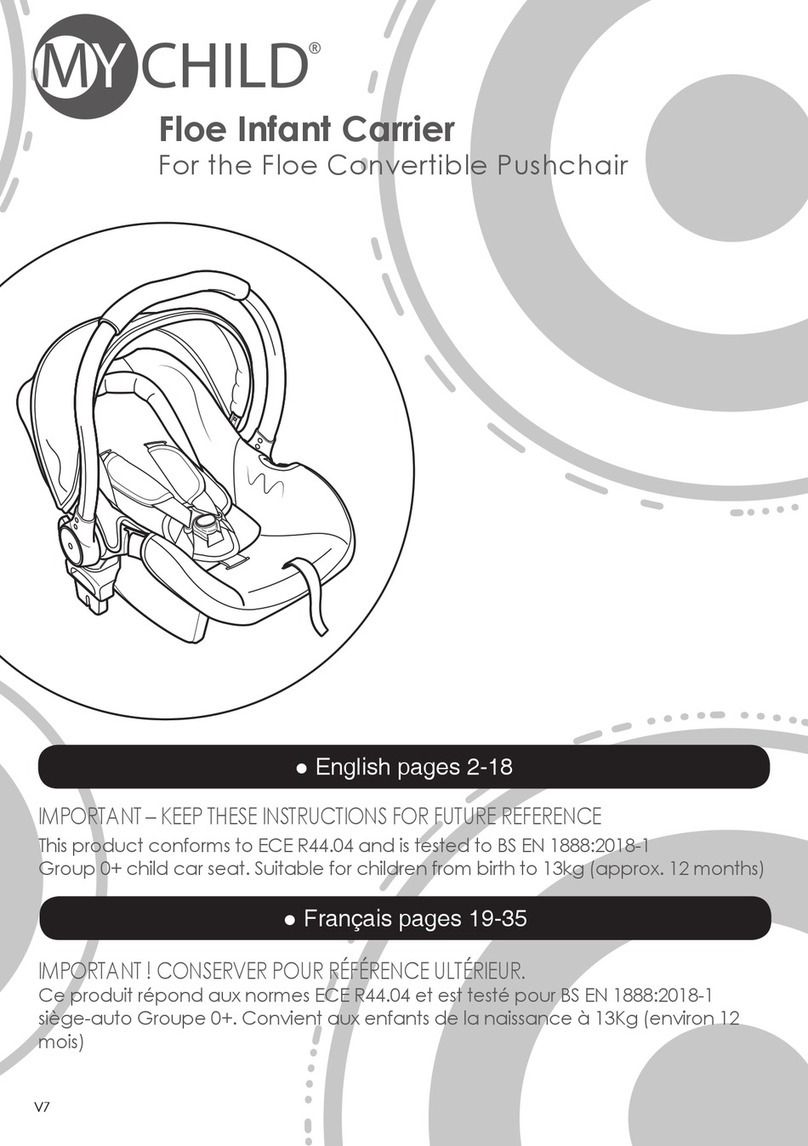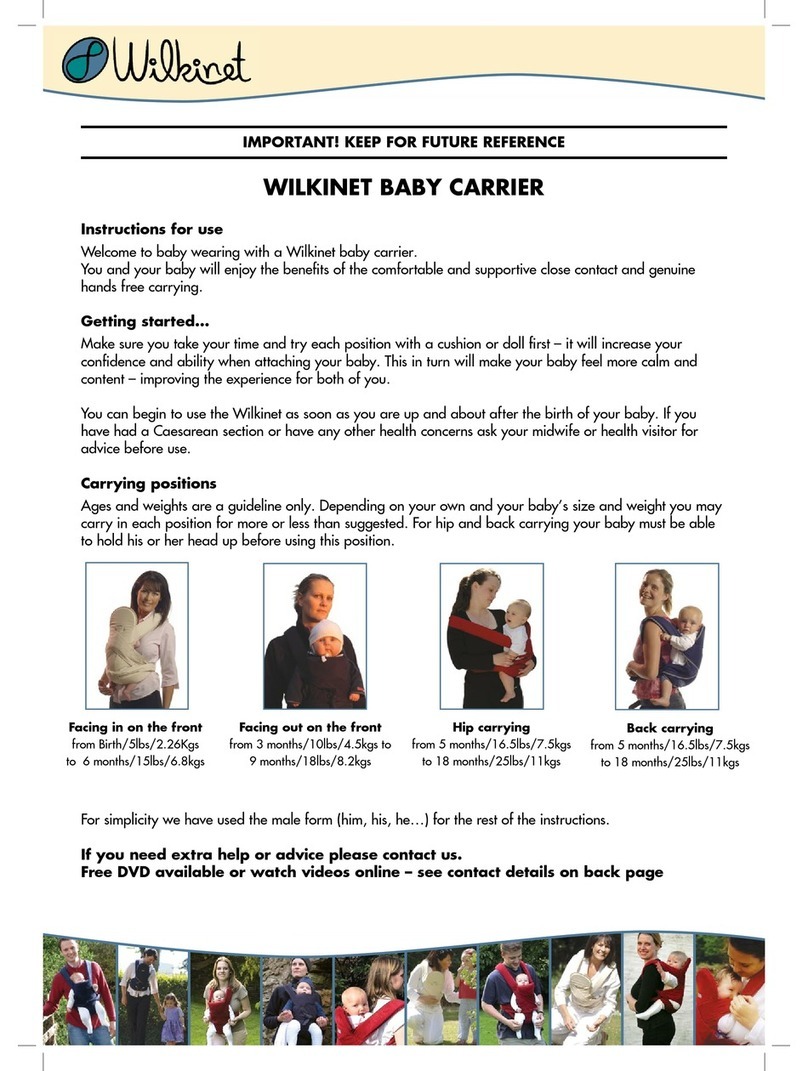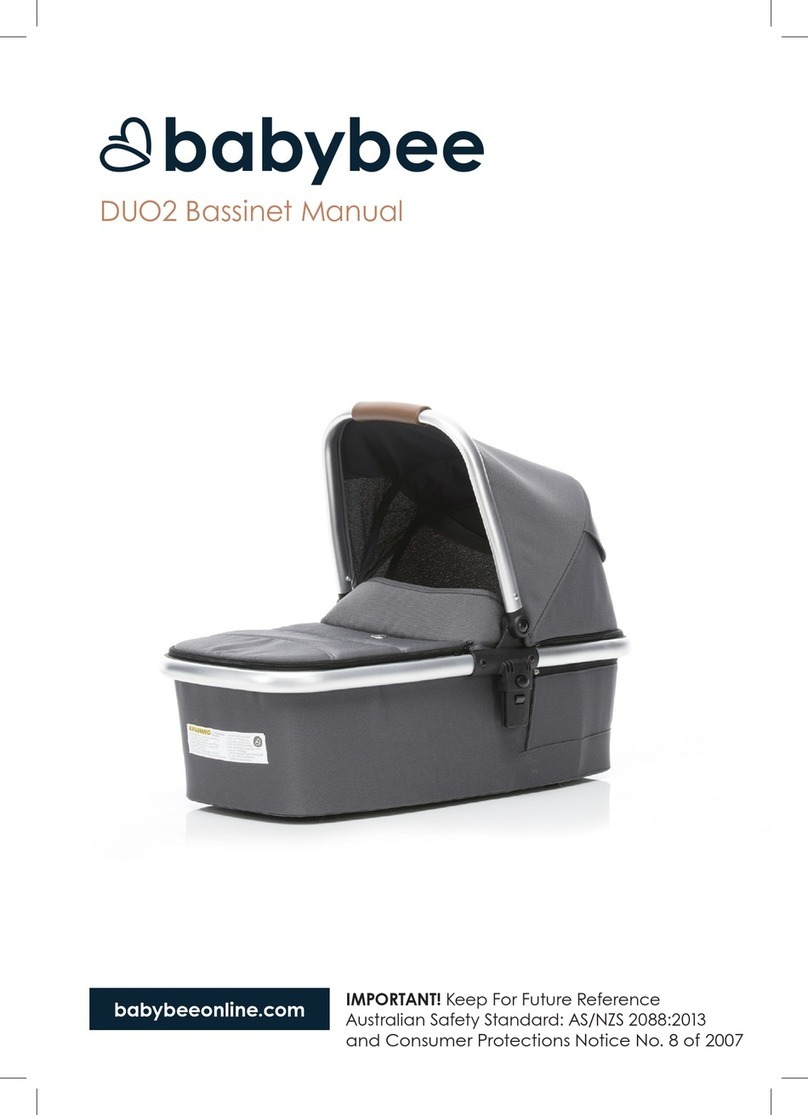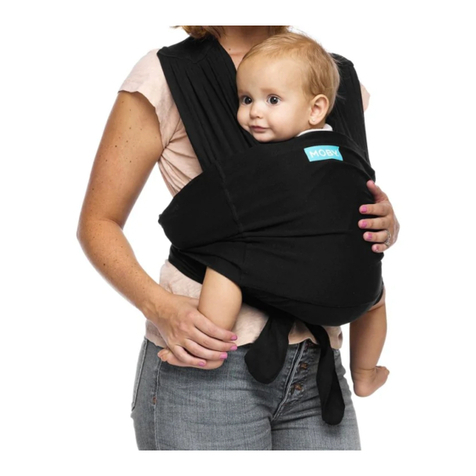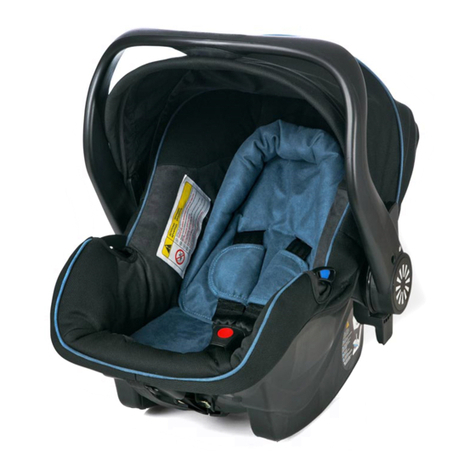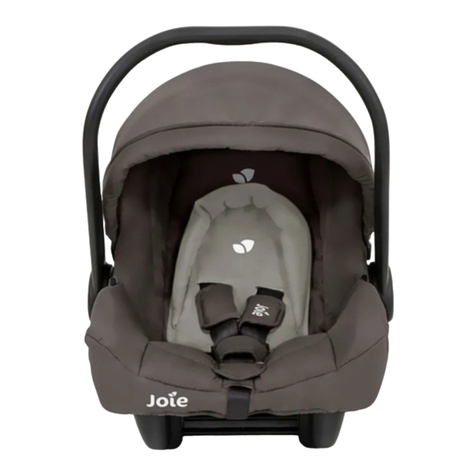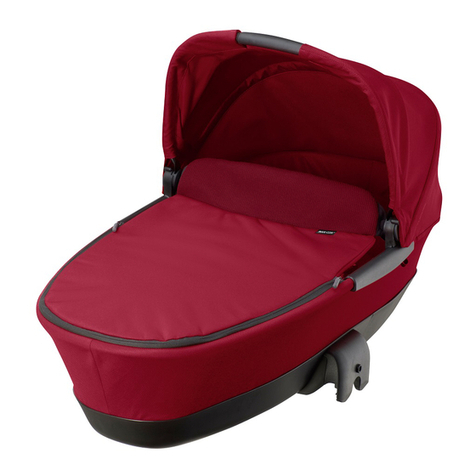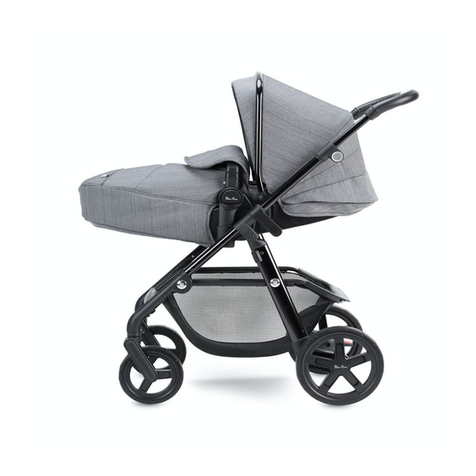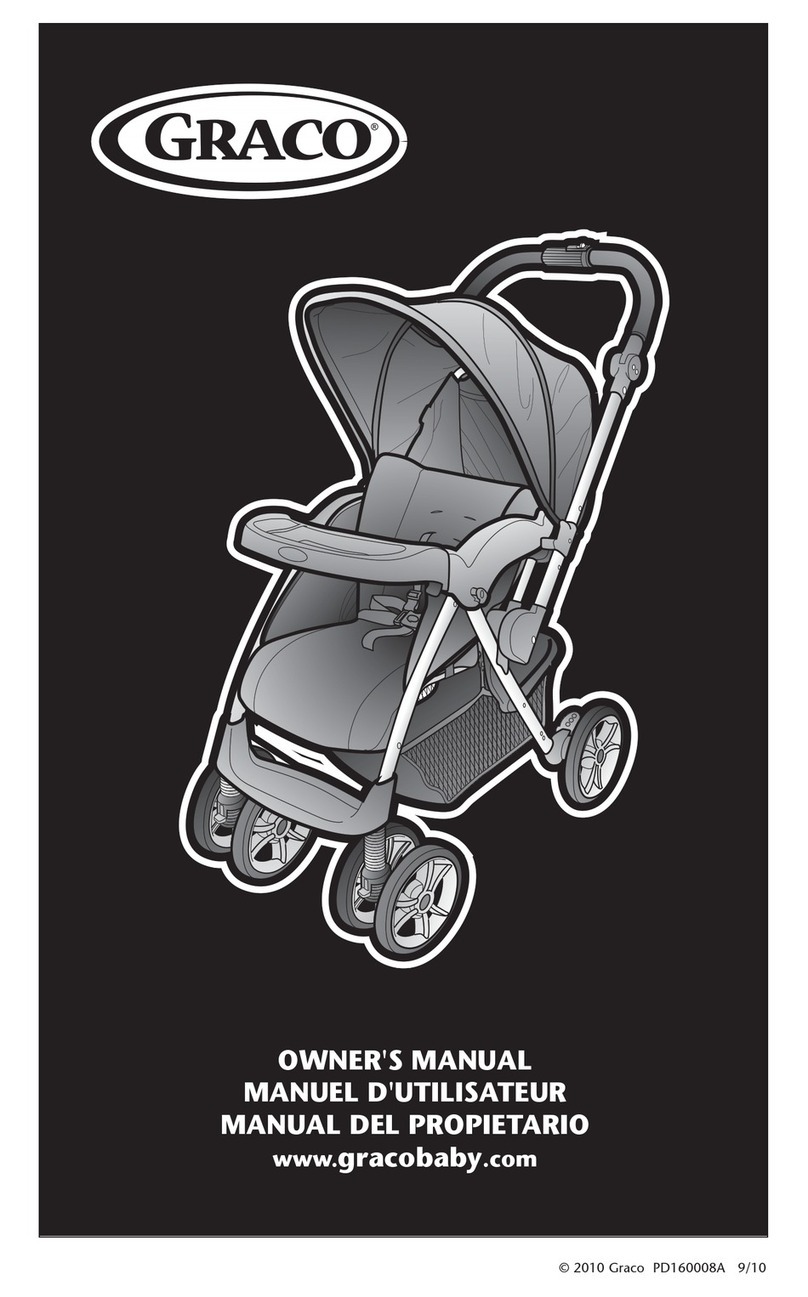My Child Vamos User manual

Vamos Infant Carrier
Instruction manual
40-87cm
max. 13kg
IMPORTANT: READ CAREFULLY AND KEEP FOR FUTURE REFERENCE.
Your child’s safety may be affected if you do not follow these
instructions.
For children from 40-87cm, up to a maximum weight of 13kg
This product conforms to ECE R129
This product is tested to EN1888-1:2018+A1:2022
IM-050723-V3

page 2
Safety advice
WARNING: The correct tting of the vehicle seatbelt (following the guide markings)
is of vital importance for the safety of your child. See the labels on the seat itself.
WARNING: Keep these instructions with the child car seat for future reference.
WARNING: Never leave your child unattended.
WARNING: NEVER use the child car seat on a passenger seat that is tted with a
front airbag. THIS CAN BE VERY DANGEROUS.
• The product is only safe if it is used in strict accordance with these instructions.
• The product must be replaced if it is involved in an accident as it may have
unseen damage.
• Do not use this product second hand as you do not know its history.
• Ensure that all other passengers, luggage and loose objects are properly
secured.
• Do not lubricate any of the moving parts.
• Never use the child car seat without the covers.
• Only covers approved by the manufacturer may be used. The covers are an
integral part of the child car seat and it’s safety performance.
• Ensure that the child car seat is not damaged by heavy objects or being
caught in the car door.
• The rigid parts and the plastic sections of the child car seat should be
positioned and installed in such a way that they cannot, under normal use of
the vehicle, become trapped by a moving seat or in the vehicle door.
• Never make unauthorised alterations or additions to the product, such
changes can be highly dangerous.
• Child car seat parts may become hot in direct sunlight. Cover with sheet to
prevent this.
• Most accidents occur on short trips, so do not be tempted to avoid using the
child car seat simply because you are not travelling very far.
• Do not leave the child in the child car seat for long periods of time. Take
regular breaks on long journeys.
• Set a good example by always wearing a seatbelt yourself.
• Make sure that your child never plays with the buckle.
WARNING: Failure to follow each of the following instructions can result in your child
striking the vehicle’s interior during a sudden stop or crash.
WARNING: Take care that the straps holding the child car seat to the vehicle, are
as tight as possible. Make sure that the straps restraining the child are adjusted to
the child’s body and the straps are not twisted.
WARNING: The child restraint system MUST BE CHANGED after it has suffered from a
violent impact in an accident.
Do not use a rear facing child car seat on a passenger seat where an
active passenger airbag is tted. The airbag inates rapidly and can
throw a rear-facing child car seat into the back of a passenger seat
with great force, which can injure or kill a child.
! Extreme Danger !

page 3
Vehicle seat travelling advice
In order to maximise the protection that the child car seat can give your child,
please adjust the harness so that it ts snugly and make sure that the child car seat
is tted correctly.
Research shows that correct installation is the most important factor in child car
seat safety.
Please take the time to read the instruction manual carefully.
This product offers maximum protection when it is used in accordance with the
instructions.
If you have any questions concerning the use of the product please do not
hesitate to contact us.
• This child car seat is designed for use for children whose weight is 13kg or less
and whose length/height is between 40 to 87cm.
• This child car seat must only be used in a rear facing position, and must NEVER
be used forward facing. For maximum protection, the centre rear seat position
(if it is tted with an adult 3-point seatbelt) is recommended as the safest
position in most vehicles for installing an child car seat. (Only use the vehicle’s
rear centre seat if the vehicle seat is tted with a 3-point adult belt).
• Do not use your child car seat on a vehicle seat with lap belts only.
• Your child car seat should not be purchased or sold as a second hand item.
• Remove child out of the car as rst priority in an accident.
• While travelling it is recommended that any luggage or other objects liable to
cause injuries in the event of a collision shall be properly secured.
• Your child car seat should be securely belted to the vehicle, even when
unoccupied because in a crash an unsecured child car seat may injure other
passengers.
• Please take a rest every two hours if you are travelling with a baby in the child
car seat.
• Please check the child car seat condition if you are going to travel a long
distance with a child.
• Please put all excess luggage into the boot of your car if you are going to
travel with a baby, because loose items may hurt a baby when travelling on
unstable roads or because they move suddenly when braking.
• Please always check the child car seat before you place a baby into it.
• Please get in touch with the dealer if anything breaks on the child car seat.
Only the manufacturer or an authorised agent may do repairs. DO NOT try
and x the child car seat by yourself. It might be damaged or cause more
damage.
• Always check the buckle hole before you buckle up as it may contain crumbs
or obstructions that prevent a secure lock.
• Keep your child car seat out of reach of children when not in use.
• Please keep the plastic packaging bag out of the reach of children when
unpacking the child car seat.
• NEVER place the child car seat on a seat where an airbag is active.
• Do not modify the child car seat.

page 4
Safety when car seat attached to Vamos chassis
7. WARNING: This product is suitable for children whose weight is 13kg or less and whose
length/height is between 40 to 87cm.
8. WARNING: Always use the restraint system.
9. WARNING: Parcels, accessories and other items (e.g. hand bags, shopping bags, etc)
that are placed on the handles, back of the backrest or sides of the pushchair will
affect the stability of the pushchair.
10. WARNING: Always use the most reclined position for new born babies.
11. WARNING: Do not lift and carry the pushchair with a child in it.
12. WARNING: Do not use pushchair on steep slopes, stairs, escalators, beaches, mud, etc.
13. WARNING: Do not allow your child to climb unassisted into or out of the pushchair.
Notices
1. The child car seat must only be used in vehicles which are tted with a
three point seatbelt system that has been approved by regulation ECE-16
or similar.
2. This is Universal Belted Enhanced Child Restraint System. It is approved
accord-ing to UN Regulation [No. 129], for use primarily in “Universal
seating positions” as indicated by vehicle manufacturers in the vehicle
user’s manual.
3. If in doubt, consult either the Enhanced Child Restraint System
manufacturer or the retailer.
Vehicle seatbelt
The product must only be used with a 3-point vehicle seatbelt that has been
approved to ECE 16 or equivalent. NEVER use a 2-point seatbelt. Your child car
seat can be tted in most cars. However, some vehicles are designed in such
away that proper installation may not be possible. In this case, try another vehicle
seat.
1. WARNING: Never leave your child unattended.
2. WARNING: Ensure that all the locking devices are engaged before
use.
3. WARNING: To avoid injury ensure that your child is kept away
when unfolding and folding this product.
4. WARNING: Do not let your child play with this product.
5. WARNING: Check that the pram body, pushchair body or seat
unit attachment devices are correctly engaged before use.
6. WARNING: This product is not suitable for running or skating.

page 5
Welcome
Thank you for purchasing the Vamos Infant Carrier.
Please read the instructions and warnings carefully before use to ensure safe and
satisfactory operation of this product.
Your child’s safety is your responsibility. If you have a query with this product or require
replacement parts, please contact your nearest MyChild retailer.
Safety advice for Vamos Chassis & car seat (continued)
14. WARNING: Ensure that children are clear of moving parts before making adjustments.
15. WARNING: Never leave raincovers, hoods and aprons on indoors or in hot weather as
your child might overheat.
16. WARNING: Do not use replacement parts or accessories other than those approved
by the manufacturer as others may render the product unsafe.
17. WARNING: Do not load the basket with a weight in excess of 2kg.
18. WARNING: Always apply the brakes when the pushchair is stationary, and when
placing and removing children.
19. WARNING: Taking children up or down stairs, escalators, steps, steep slopes and
muddy/rough terrain could be dangerous and should not be attempted. Remove
your child from the pushchair for easy carrying to negotiate such hazards, or simply
avoid them.
20. WARNING: Never assume a driver can see you or your child.
21. WARNING: If your pushchair is to be used by someone who is unfamiliar with it, e.g.
grandparents, then show them how it works before letting them use it.
22. WARNING: Hold onto your pushchair when close to moving vehicles and trains as the
draught from the vehicles may move the pushchair even with the brakes on.
23. WARNING: This product is designed to carry only one child at a time.
24. WARNING: This product is not intended for prolonged periods of sleeping.
This product complies with EN1888-1:2018+A1:2022
Whilst we make and test our products to the highest standards of durability there’s
always a small chance of a hiccup! Our promise is to repair, replace or refund a MyChild
product that has an identied manufacturing defect from the date of purchase for a full
3 years thereafter at no extra cost.
However, you must register within 28 days of the date of purchase to receive the full 3
years guarantee!
To receive your full guarantee you can register your product by:
visiting www.mychild.co.uk/warranty.html and complete the warranty form,
or by telephone on 0161 335 2508.
Your 3 year warranty

page 6
1Carry handle
2Headrest
3Shoulder pads
4Harness buckle
5Insert cushion
6Harness adjuster button
(under seat cover)
7Harness adjuster strap
8Button to remove adapters
(under edge of seat cover)
9Crotch pad
10 Instruction manual storage
(under seat cover)
11 Diagonal seatbelt guide
12 Headrest height-adjuster
13 Hood
14 Lap belt guides
15 Carry handle adjuster buttons
16 Shell
17 Stroller attachment adaptors (REMOVABLE)
Parts checklist
6
58
9
1
2
3
4
7
17
16
14
11
13
15
12
10

page 7
11 Diagonal seatbelt guide
12 Headrest height-adjuster
13 Hood
14 Lap belt guides
15 Carry handle adjuster buttons
16 Shell
17 Stroller attachment adaptors (REMOVABLE)
Front passenger seat (no active
airbag)
Yes
Front passenger seat (active
airbag)
NO
2-point seatbelt NO
3-point seatbelt Yes
Back left & right seats Yes
Back centre seat (3-point seatbelt) Yes
Back centre seat (2-point seatbelt) NO
Side facing seats NO
Rear facing seats NO
Positioning the child car seat
1. The child car seat can only be used with
an automatic 3-point safety belt (A) and
NOT with a 2-point lap belt (B).
The child car seat can be secured on
forward-facing back seats of the vehicle by
using the existing seat belts. However, on
some seats, if the installation is not properly
secured, we suggest you try another seat in
your vehicle.
Although not recommended, the child car
seat can be used on a passenger side front
seat, so long as there is no active airbag in
place.
WARNING: NEVER use on a seat with an
active airbag.
WARNING: NEVER use on rearward or side
facing vehicle seats
2. When tted on a rear seat:
The child car seat must not touch the front
passenger seat.
AB

page 8
3. The carry handle has 4 positions.
(i) Feeding/non-rocking position.
(ii) Rocking position.
(iii) Carrying position: Make sure handle is
locked before lifting.
(iv) Fitting position.
Press both buttons (A) and rotate the
handle to the desired position.
WARNING: NEVER place the child car seat
on an elevated surface e.g. a table.
WARNING: NEVER place the child car seat
on a soft surface e.g. cushion, mattress,
pillow etc, due to risk of suffocation if child
car seat tips over.
WARNING: NEVER leave a child
unattended.
Adjusting the carry handle
i
ii
ii
iv
A
Opening the harness
4. Press the belt adjuster button (A) and
pull on the shoulder harness straps to
create slack.
click
B
A
5. Press the red release button (B),
unbuckle the harness and move the
shoulder straps apart.

page 9
Fastening the harness
click
D
CC
6. Connect the two shoulder strap
connectors (C) and insert into the buckle
(D). Ensure harness buckle is rmly clicked
into place.
7. Pull the harness adjuster strap tight (E)
and check straps are not twisted.
Ensure you use the supplied insert cushion
(F) if you are going to use the child car
seat for a newborn or small baby between
40 and 60cm in length.
Adjusting the headrest/shoulder harness height
8. Squeeze the headrest height-adjuster
(A) and slide the headrest up or down as
desired.
Important: If raising the hearest - ensure
you have loosened the shoulder straps
enough so as to prevent any resistance
from the straps.
WARNING: You should not attempt to adjust the headrest/harness height with a child
seated in the child car seat.
F
C
A

page 10
Using the harness
9. The shoulder harness should exit the
child car seat at the same height as the
child’s shoulders and should not exit higher
or lower than this.
WARNING: You should not attempt to adjust
the headrest/harness height with a child
seated in the child car seat.
Adjusting the headrest/shoulder harness height (cont)
10. Press the belt adjuster button (A) and
pull on the shoulder harness straps to
create slack.
click
B
11. Press the red release button (B),
unbuckle the harness and move the
shoulder straps apart.
A

page 11
12. Place the child in the child car seat and ensure there are no spaces under the child.
IMPORTANT: Small babies often need extra support around the body. Always use the
supplied insert cushion (C) for a small babies between 40 and 60cm in length.
WARNING: Do not place your child in a sleeping bag, blanket or other bulky wrapping
before putting the child in the child car seat. The shoulder straps will not t snugly and the
child will not be safe.
Using the harness (continued)
13. Place the harness over the child’s
shoulders and buckle up the harness.
Connect the two shoulder strap
connectors (D) and insert into the buckle
(E). Ensure harness buckle is rmly clicked
into place.
click
E
DD
14. Pull the harness adjuster strap tight (F)
and check straps are not twisted.
F
C

page 12
B
click
2cm
Using the harness (continued)
15. The harness should allow 1 nger-width
(2cm approx) of space at the top of the
shoulders. This is the ideal tightness.
Note: Check that the buckle is secured by
tugging the shoulder straps.
16. Choose a seat suitable for tting the
child car seat to. See page 7, ‘Positioning
the child car seat’.
Place the child car seat rearward-facing
on the vehicle seat.
Ensure the handle is in the tting position as
shown.
Fitting the child seat in a vehicle
A
A
17. Place the vehicle lap belt across the child car seat and slide the lap belt into the slots
(A) on both sides of the child car seat.
Buckle up the vehicle seat belt (B).

page 13
Fitting the child seat in a vehicle (continued)
18. Take the diagonal belt around the
back of the child car seat and slot it into
the rear seat belt guide (C).
Once the seat belts are in their correct
mounting points make sure the seat belt
buckle is secure and there are no twists in
the belt and that all slack is removed from
the lap and diagonal sections.
C
19. If the vehicle seatbelt buckle is above or touching the top edge of the shell then
this car seat is not suitable for the vehicle and may cause the vehicle seatbelt to come
undone in an accident.

page 14
click
click B
Attaching the seat to the chassis
Using the stroller attachment adaptors
22. Hold the car seat so that it is facing
the stroller handle. Position the car seat
adaptors (A) above the mounting points
(B) and push the seat downwards until it
clicks into place.
Note: The car seat can only be tted
parent facing (as shown).
Attention: Lift the car seat to ensure it is
rmly attached to the stroller chassis.
20. To attach the adaptors: push each
adaptor into the socket directly below
the carry handle joint.
Note: There are two adaptors. Each
adaptor is marked with a letter “L” for left
and “R” for right and will only t one side
of the car seat.
21. To remove the adaptors: press the red
release button (A) and pull the adaptor
out from the socket.
Note: The release button (A) is located
under the edge of the seat fabric.
A
A
WARNING! DO NOT attempt to attach the car seat to the stroller with a child in the car
seat.
A

page 15
A
Removing the seat from the chassis
Removing the seat cover
23. Standing in front of the chassis, lift up the release catches (A) on each side of the car
seat and lift it from the chassis.
WARNING! Never use the child car seat without the covers.
The seat cover can be removed for washing, however the headrest cover cannot be
removed. See “Care and Maintenance” for details on cleaning the removable and non-
removable covers.
24. Place the carry handle in the non-
rocking position.
25. Remove the shoulder pads (A) and
crotch pad (B).
Place the shoulder straps (C) behind the
seat cover.
Remove the buckle (D).
A
B
D
C
A

page 16
G
F
E
Removing the seat cover (continued)
Retting the seat cover
26. Remove the hood fabric from around
the back of the seat and pull the hood
forward.
Unhook all the plastic clips (E), (F), (G)
and remove the elastic loops from the
two clips (F) near the hood xing point.
27. Carefully pull the cover out from under
the lap belt guides - taking care not to
break the elastic.
Tip: Gently ease the lap belt guides
inwards to open a gap on the outside
and allow the elastic to be removed.
28. Pull the seat cover up from the back
of the seat and carefully pull it over the
headrest and free from the seat.
WARNING! Never use the child car seat without the covers.
Reverse steps 24-28 to re-t the seat cover.

page 17
Removing the hood fabric
29. Remove the hood fabric from around
the back of the seat and pull the hood
forward.
Unhook plastic clips (A) and remove the
elastic loops from the two clips.
30. Remove the hood fabric from the clips
(B) along the inside of the plastic hood
visor.
Reverse steps 29-30 to re-t the hood
A
B

page 18
Care and maintenance
1) Store this child car seat, when not in use, in a safe place away from direct sunlight.
2) DO NOT place heavy objects on top of it.
3) Always store the child car seat in a dry environment.
4) DO NOT store the child car seat near a direct heat source such as a radiator.
Removable Fabrics
1) All the removable fabrics can be hand washed with pH neutral soap and cold water.
2) DO NOT press, iron, dry clean, tumble dry or wring the covers.
3) DO NOT use solvents, caustic or abrasive cleaning materials.
4) Dry at, away from direct heat and sunlight.
5) If the seat covers need to be replaced only use parts certied by the manufacturer.
They are the only ones that are guaranteed to have been safety tested and designed to
t this seat.
Non-removable Headrest Cover
1) Wipe with a damp cloth or sponge. DO NOT soak the headrest cover.
2) DO NOT use solvents, caustic or abrasive cleaning materials.
3) Dry at, away from direct heat and sunlight.
Plastic/Metal Parts
1) Wipe clean only, using a mild soap and warm water.
2) DO NOT immerse the car seat in water.
2) You MUST NOT remove, dismantle or alter any part of the seat shell.
3) You MUST NOT oil or lubricate any part of the seat shell.
Inspection
1) Check your child car seat regularly for wear and tear.
2) The child car seat may have a slight rattle when not in use, this is normal. If in any doubt,
contact the retailer immediately.
3) Check the adjustable parts of your child seat at intervals of about 6 months to ensure it is
still ts correctly for your growing child.

page 19
Table of contents
Other My Child Baby Carrier manuals

